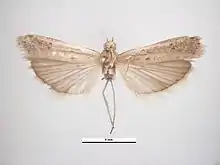| American sunflower moth | |
|---|---|
 | |
| Scientific classification | |
| Domain: | Eukaryota |
| Kingdom: | Animalia |
| Phylum: | Arthropoda |
| Class: | Insecta |
| Order: | Lepidoptera |
| Family: | Pyralidae |
| Genus: | Homoeosoma |
| Species: | H. electellum |
| Binomial name | |
| Homoeosoma electellum | |
| Synonyms | |
| |
Homoeosoma electellum, the American sunflower moth, is a species of moth of the family Pyralidae. It is native to North America but also found in South America. Its larvae eat the flowers and developing seeds of many asters, including echinacea.
The wingspan is 18–20 mm. Adults have off-white wings with a number of dark scale spots as well as dark scales on the distal one third of the wing.[2]
The larvae are a pest of canola and sunflowers. Other recorded food plants include cotton and oranges.
References
- ↑ "GlobIZ search". Global Information System on Pyraloidea. Retrieved 2011-10-07.
- ↑ (Hulst, 1887). "Padil". Padil. Retrieved 2011-10-07.
{{cite web}}: CS1 maint: numeric names: authors list (link)
This article is issued from Wikipedia. The text is licensed under Creative Commons - Attribution - Sharealike. Additional terms may apply for the media files.